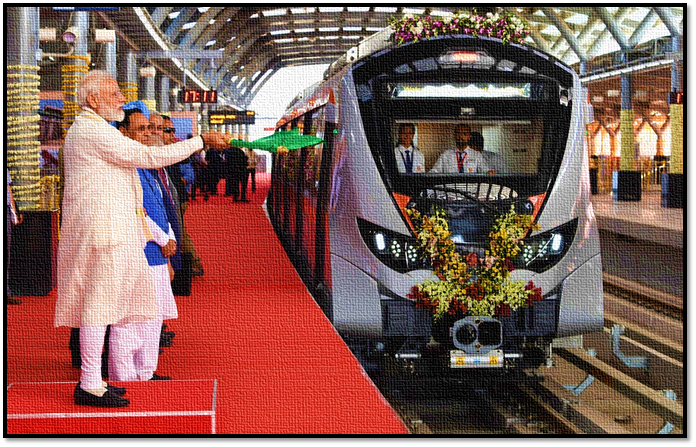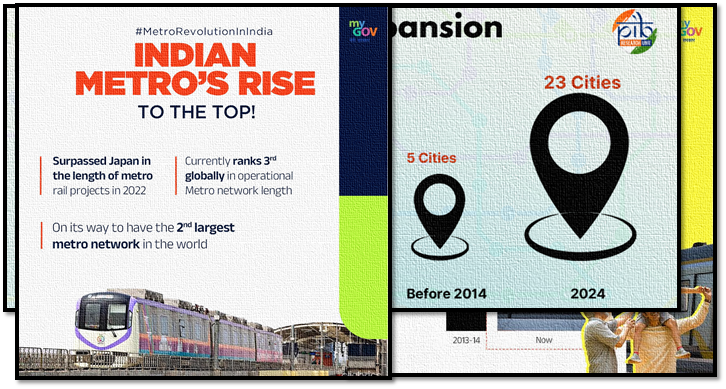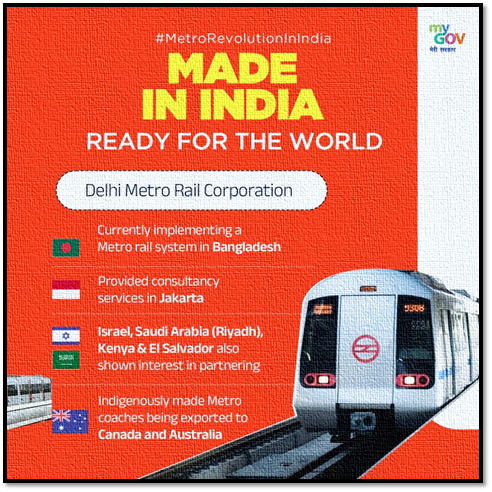
Metro systems have transformed travel in India. Covering over 1,000 km across 11 states and 23 cities, millions of people rely on them for quick, easy and affordable travel. With this growth, India has become home to the third-largest metro network in the world. Metros are not just a way to get around—they are changing how we live and move in cities.
The Future of Fast, Safe, and Reliable Travel

New Delhi:(PIB) On January 5, Prime Minister Narendra Modi took a giant leap in enhancing India’s metro network, making it more powerful and advanced. He laid the foundation for multiple development projects worth over Rs 12,200 crore in Delhi, including the inauguration of the 13 km stretch of the Delhi-Ghaziabad-Meerut Namo Bharat corridor, which will greatly ease travel between Delhi and Meerut. In addition, the PM launched a 2.8 km stretch of Delhi Metro Phase-IV, benefiting West Delhi and laid the foundation for the 26.5 km Rithala-Kundli section, further strengthening connectivity between Delhi and Haryana.
These projects represent a major milestone in transportation, as metro systems now cover greater distances and serve over 1 crore passengers daily. With this growth, India has surpassed Japan in Metro Rail Projects in 2022. Currently, India ranks third globally in operational Metro network length and is on track to become the 2nd largest Metro network in the world.
Milestones in the History of Metro in India
The corridors and lanes of metro systems have reshaped urban travel in India, with a journey that began decades ago. In 1969, the initiative for a metro system was launched through the Metropolitan Transport Project. However, it took nearly two decades for the first step to become a reality.
1984: The first metro line in India, covering 3.4 km between Esplanade and Bhowanipur, opened in Kolkata. This marked the beginning of metro life in India
1995: The Delhi Metro Rail Corporation (DMRC) was established to bring world-class Mass Rapid Transport to Delhi. The project gained momentum with joint participation from the Central Government and the Government of Delhi
2002: DMRC opened its first metro corridor between Shahdara and Tis Hazari in Delhi, setting the stage for one of the country’s largest metro networks
2011: Namma Metro’s (Bengaluru Metro) first segment was built
2017: Chennai’s metro expanded with the inauguration of its first underground section on the Green Line, from Koyambedu to Nehru Park, marking a key milestone for Southern India’s metro development
2020: Phase 1 of Kochi Metro was completed, with the Thykoodam-Petta stretch commissioned, making Kerala part of the growing metro network in India
These key developments in metro systems across major cities laid the foundation for the vast and efficient metro network that connects millions today.
Advancements in Metro Systems
Metro expansion in India has gone beyond just land-based transport, embracing innovative solutions for the future. From under-river tunnels to driverless trains and water metros, India is setting new standards in modern urban mobility.
Under-Water Metro: In 2024, PM Modi inaugurated India’s first under-water metro tunnel in Kolkata, where the Esplanade-Howrah Maidan section passes beneath the Hooghly River. This remarkable feat showcases India’s engineering capabilities.
Ø Driverless Metro: On December 28, 2020, India launched its first-ever driverless metro service on Delhi Metro’s Magenta Line, setting a new benchmark for automation in public transport.
Ø Kochi Water Metro: Kochi, Kerala, became the first city in India to launch a Water Metro Project, connecting 10 islands around the city with electric hybrid boats. This groundbreaking initiative ensures seamless connectivity, with the first boat launched in December 2021.
Ø Approval of three Metro Rail Projects:
· Bengaluru Metro Project: 44 km expansion comprising two corridors.
· Thane Metro Project: 29 km network aimed at reducing congestion on the roads of Thane.
· Pune Metro Project: A 5.5 km route to further improve urban mobility in the city.

Along with domestic progress, there is increasing international interest in India’s expertise in metro rail systems.
The Delhi Metro Rail Corporation (DMRC) is currently overseeing the implementation of a metro system in Bangladesh and has offered consultancy services in Jakarta. Countries such as Israel, Saudi Arabia (Riyadh), Kenya and El Salvador are also exploring collaborations with DMRC for their metro development projects.
Conclusion
India’s metro systems have come a long way, from the first steps in Kolkata to the advanced technological features seen today. With projects expanding across cities and innovations like driverless trains and under-river tunnels, the metro network is not just reshaping travel, but also contributing to sustainable urban development. As the network continues to grow, it sets new standards for urban mobility and paves the way for a more connected future.





